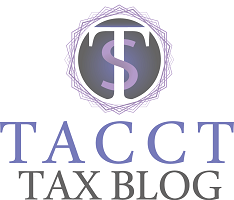Everyone wants to save money on their taxes, right? Well you’re not going to be able to do this unless you plan accordingly. To make the most of some tax deductions, you have to act before the year is over.
For business owners and individuals alike, maximizing tax deductions and decreasing taxable income (revenue) is the goal. You can optimize your tax strategy by making small decisions throughout the year. Depending on what you do and when you decide to do it, your tax obligations can be dramatically different.
As we approach the end of 2018, it’s wise to consider tips that can help you when filing your taxes next year. Because tax laws change regularly, it’s always wise to contact TACCT to assist with your tax strategy.
With that in mind, here are a few year-end tax tips for individuals and small business owners.
- Defer Income
- Recognize Expenses
- Contribute to Retirement
- Donate to Charity
To defer your income is to push recognizing earnings until the next calendar year. Because you are only taxed on the income you earn within the year; deferring can help you delay taxes on income that you would receive near the end of the year.
If you have done well tracking your records throughout the year, you should have a good idea what your taxable earnings are going to look like when it comes time to file. Just as you might defer earnings into the next year, you can also lower your tax bill by recognizing expenses earlier.
Contributing to retirement accounts that are tax-deferred will not just benefit you in the long run, it can also help you avoid immediate tax fees. A retirement plan like a 401(k) can be a great investment — especially if your company matches your contributions. 401(k) contributions are made throughout the year, meaning the deductions are already recognized on your taxable income.
Donating to a nonprofit organization has more than just philanthropic benefits — it can also help you increase your charitable tax deduction. Interestingly, your charitable deduction is based on your tax bracket. For instance, if you find yourself in the 25% tax bracket, you can deduct $0.25 for every dollar you donate.
Specific Year-End Tax Moves to Consider
Here are a few more things to consider when you’re handling income at year’s end, depending on whether you want to decrease your income or increase it.
| Type of income |
Lowering Your Income |
Increasing Your Income |
| Wages |
- Boost pretax contributions to your 401(k) or similar retirement plan to reduce your income.
- Ask if a year-end work bonus can be paid out next year instead of this year.
- Hold off on exercising incentive stock options.
|
- Work overtime, ask for a raise, reduce pretax retirement contributions, shift retirement contributions to an after-tax Roth 401(k) or Roth 403(b).
- Exercise incentive stock options.
|
| Business Income |
- Spend on tax-deductible expenses such as equipment and supplies. Remember to track your expenses.
- Make payroll tax deposits this year instead of waiting until the Jan. 15 deadline so you can deduct Q4 payroll tax this year.
- Hold off on sending out invoices and collecting on accounts receivable until next year.
- Identify business losses that can offset other income.
- Review retirement plans and consider setting up a solo 401(k) before the end of the year.
|
- Send out invoices and try to collect on outstanding accounts receivable by the end of the year.
- Wait to spend money on business expenses until January.
|
| Capital Gains and Losses |
- Use installment sales or like-kind exchanges to defer gains to a future year.
- Long-term capital gains have their own tax brackets in 2018 due to changes made by the TCJA. If your income is $425,801 or more as a single taxpayer, $452,401 or more as head of household, or $479,001 if you’re married and filing a joint return, long-term gains are taxed at 20 percent instead of 15 percent. Most taxpayers pay 15 percent. Your gains might also be subject to the 3.8 percent net investment income surtax.
- Consider “loss harvesting.” Sell off positions with unrealized losses to reduce taxable gains.
- Be careful about repurchasing investments sold at a loss within 30 days. This can create a wash sale.
- Hold off on selling profitable positions until next year.
- Ensure that carryover losses apply to short-term gains whenever possible.
- Rebalance your portfolio across tax types for utmost tax efficiency.
|
- Consider “gain harvesting.” Sell any long-term gains to fill up taxable income to the top of the 15 percent bracket. Such gains will be taxed at zero percent.
|
| Retirement Distributions |
- If you need to withdraw a substantial amount from a retirement plan, figure out if it’s better to take the money this year versus next year, or spread out the tax impact by withdrawing some this year and some next year.
|
- Take required minimum distributions (RMDs) by the end of the year.
- If you turned 70½ years old in 2017, your first RMD should have been taken by April 1, 2018, but you can delay it until the year after you turn 70½. Figure out if it’s more advantageous to take the RMD this year or to take two RMDs next year.
|
| Converting Pretax IRA to an After-tax Roth IRA |
|
- This increases your taxable income in the year of conversion.
- You can undo a conversion by April 15 or Oct. 15. This makes sense if the tax cost is low enough compared to the expected future tax cost.
|
| Social Security Benefits |
|
- Earning more income can mean that more of your benefits will be taxable.
|
| Passive Losses From Rentals and Businesses |
- Figure out if your passive losses will be limited or deductible this year. If so, passive losses can offset other income. If not, the losses roll forward.
|
- Consider increasing your passive income to use up your loss carryovers.
|
| Net Operating Losses |
- Exercise carry back/carry forward options to offset income in other years.
|
- Increase income to absorb the losses. This makes the additional income tax-free up to the extent of the loss.
|
These tips can help you handle expenses at the end of the year:
| Type of Expense |
Accelerating Expenses |
Deferring Expenses |
| Itemized Deductions |
- Figure out if you can or should itemize this year and/or next year by comparing the total of your itemized deductions to the standard deduction for your filing status. Keep in mind that the TCJA pretty much doubles standard deductions to $12,000 for single filers, to $18,000 for heads of household, and to $24,000 for those who are married and file jointly.
|
- It might make more sense to itemize this year rather than next year because these standard deductions are indexed for inflation and can be expected to increase slightly. Identify expenses that can be paid in 2018.
|
| Medical, Dental, and Health Care
|
- Medical, dental and health care expenses in excess of 7.5 percent of your AGI are tax deductible in 2018, but this figure will go back up to 10 percent in 2019.
- Consider paying additional medical expenses before the end of the year to get your deduction over the threshold.
|
- If you had significant medical expenses in 2018, look into whether you can pay your medical bills next year instead. By “bunching” your medical expenses into one year, you might be able to get over 2019’s 10 percent threshold.
|
| State estimated taxes |
- Pay your state estimated income taxes by the end of the year to deduct them this year. This only works if you are or will be able to itemize and you’re not subject to the alternative minimum tax.
- Hold off on paying your Q4 state estimates until January if it will be more advantageous to deduct them on your 2019 return.
|
|
| Property taxes |
- Pay your next property tax installment before the end of the year to deduct it this year. Remember, you can only do this is the tax has been officially assessed. This only works if you are or will be able to itemize and you’re not subject to the AMT.
|
- Pay your next property tax installment in 2018 to deduct it in 2018 if it’s been assessed before year’s end.
|
| Charity |
- Donate cash by December 31 to deduct the donation this year.
- Donate non-cash goods such as clothes, furniture or vehicles by December 31 to get a deduction this year.
- Consider a Donor Advised Fund if you want to give but you’re not sure which charity you would like to donate to.
- Postpone donations until next year if the deduction will produce bigger tax savings in 2018.
|
- Pick the right year so the charity generates the most tax savings.
|
Here are a few considerations about saving money at the end of the year:
| 401(k) or 403(b) Retirement Plans |
- Contributions for employee contributions for 2018 must be made by December 31 or deferred from your last paycheck of the year.
- Decide how much you want to set aside from each paycheck so you’re ready to go in January for 2019 contributions.
- Decide how much to allocate for pretax traditional and/or after-tax Roth accounts for 2019.
|
| Traditional IRA |
- Contributions for 2018 tax year are due by April 15, 2019, so topping off your IRA can wait until next year if necessary.
- Determine how much, if any, of your traditional IRA contributions will be tax-deductible.
|
| Roth IRA |
- Contributions for tax year 2018 are due by April 15, 2019.
- Determine how much, if any, you are eligible to contribute to a Roth IRA.
- Consider funding a Roth IRA and taking the Saver’s Credit if you’re eligible.
|
Tax preparation is often about executing a tax strategy throughout the year. As you approach the end of the calendar year, it can be financially beneficial for you to make specific choices. As we near another tax season, consider the ideas above to help you save on your taxes.
Follow us: @the_tax_lady | TACCT on Facebook
Read our Tax Insight Newsletters
Schedule a Tax Appointment



